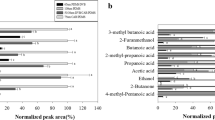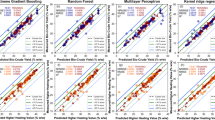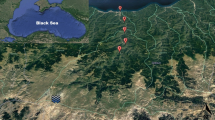Abstract
The hydrogenation process of soybean oil is monitored through time-consuming methodologies that demand sample preparation and produce chemical residues. Thus, it is necessary to develop faster low-cost waste-free instrumentation methodologies. The aim of this work was to evaluate an ultra-compact near-infrared spectrometer in tandem with the partial least squares regression (PLSR) or support vector regression (SVR) in the control of the hydrogenation process. Models were used to predict the saturated fatty acids (SFA), unsaturated fatty acids (UFA), monounsaturated fatty acids (MUFA), trans fatty acids (TFA), polyunsaturated fatty acids (PUFA), and the iodine value (IV). The values predicted by the PLSR and SVR models were compared to the experimental values obtained by gas chromatography. A methodology for feature selection was also assessed, which was able to reduce by up to 85% the variables used in the models without loss of performance. The values obtained for root mean square error of cross validation, root mean square error of calibration, root mean square error of prediction, and r 2 remained very close for both PLSR and SVR. Regarding RSD, all values were above 5% for the PLSR models, whereas for the SVR, the RSD presented values lower than 5% for IV and UFA. It is worth noting that the spectrometer used has low cost, effortless assembly, and easy handling, which allows its use in any environment. Through the results obtained, it was demonstrated that the ultra-compact NIRS spectrometer in tandem with PLSR or SVR represent an alternative to monitor the industrial hydrogenation process of soybean oil.





Similar content being viewed by others
References
AOCS (2012) Iodine value (calculated from GLC). In: Firestone D (ed) Official methods and recommended practices of the AOCS, 6th edn. AOCS Press, Urbana, p 1200
Barbin DF, Felicio ALDSM, Sun D-W et al (2014) Application of infrared spectral techniques on quality and compositional attributes of coffee: an overview. Food Res Int 61:23–32. doi:10.1016/j.foodres.2014.01.005
Bona E, Borsato D, Sérgio R, Herrera P (2000) Aplicativo para otimização empregando o método simplex seqüencial. Acta Sci 22:1201–1206
Bona E, Marquetti I, Link JV et al (2017) Support vector machines in tandem with infrared spectroscopy for geographical classification of green arabica coffee. LWT - Food Sci Technol 76:330–336. doi:10.1016/j.lwt.2016.04.048
Bosque-Sendra JM, Cuadros-Rodríguez L, Ruiz-Samblás C, de la Mata AP (2012) Combining chromatography and chemometrics for the characterization and authentication of fats and oils from triacylglycerol compositional data—a review. Anal Chim Acta 724:1–11. doi:10.1016/j.aca.2012.02.041
Botelho BG, Mendes BAP, Sena MM (2013) Implementação de um método robusto para o controle fiscal de umidade em queijo minas artesanal. Abordegem metrológica multivariada. Quim Nova 36:1416–1422
Burns DA, Ciurczak EW (eds) (2008) Handbook of near-infrared analysis, 3rd edn. Boca Raton, CRC Press
Chang C-C, Lin C-J (2011) LIBSVM: a library for support vector machines. ACM Trans Intell Syst Technol 2:1–27. doi:10.1145/1961189.1961199
Cunha S (2003) Estabilidade relativa de alcenos: análise dos critérios encontrados nos livros textos de graduação e uma proposta de explicação operacional para alcenos dissubstituídos. Quim Nov 26:948–951
de Jong S (1993) SIMPLS: an alternative approach to partial least squares regression. Chemom Intell Lab Syst 18:251–263. doi:10.1016/0169-7439(93)85002-X
Dijkstra AJ (2012) Kinetics and mechanism of the hydrogenation process—the state of the art. Eur J Lipid Sci Technol 114:985–998. doi:10.1002/ejlt.201100405
Ferreira MMC (2015) Quimiometria, Conceitos, Metodos e aplicações, 1st edn. Editora Campinas, Campinas
Gao F, Han L (2012) Implementing the Nelder-mead simplex algorithm with adaptive parameters. Comput Optim Appl 51:259–277. doi:10.1007/s10589-010-9329-3
Gaze LV, Oliveira BR, Ferrao LL et al (2015) Preference mapping of dulce de leche commercialized in Brazilian markets. J Dairy Sci 98:1443–1454. doi:10.3168/jds.2014-8470
Gupta MK (2010) Practical guide to vegetable oil processing, 1st edn. AOCS Press, Illinois
Hashempour-Baltork F, Torbati M, Azadmard-Damirchi S, Savage GP (2016) Vegetable oil blending: a review of physicochemical, nutritional and health effects. Trends Food Sci Technol 57:52–58. doi:10.1016/j.tifs.2016.09.007
Hocevar L, Soares VRB, Oliveira FS et al (2012) Application of multivariate analysis in mid-infrared spectroscopy as a tool for the evaluation of waste frying oil blends. J Am Oil Chem Soc 89:781–786. doi:10.1007/s11746-011-1968-8
Javidnia K, Parish M, Karimi S, Hemmateenejad B (2013) Discrimination of edible oils and fats by combination of multivariate pattern recognition and FT-IR spectroscopy: a comparative study between different modeling methods. Spectrochim Acta Part A Mol Biomol Spectrosc 104:175–181. doi:10.1016/j.saa.2012.11.067
Jiang L, Liu F, He Y (2012) A non-destructive distinctive method for discrimination of automobile lubricant variety by visible and short-wave infrared spectroscopy. Sensors 12:3498–3511. doi:10.3390/s120303498
Jovanović D, Čupí Ž̌, Stankoví M, et al (2000) The influence of the isomerization reactions on the soybean oil hydrogenation process. J Mol Catal A Chem 159:353–357. doi: 10.1016/S1381-1169(00)00154-0
Karoui R, Downey G, Blecker C (2010) Mid-infrared spectroscopy coupled with Chemometrics: a tool for the analysis of intact food systems and the exploration of their molecular structure-quality relationships—a review. Chem Rev 110:6144–6168. doi:10.1021/cr100090k
Link JV, Lemes ALG, Marquetti I et al (2014) Geographical and genotypic classification of arabica coffee using Fourier transform infrared spectroscopy and radial-basis function networks. Chemom Intell Lab Syst 135:150–156. doi:10.1016/j.chemolab.2014.04.008
Marquetti I, Link JV, Lemes ALG et al (2016) Partial least square with discriminant analysis and near infrared spectroscopy for evaluation of geographic and genotypic origin of arabica coffee. Comput Electron Agric 121:313–319. doi:10.1016/j.compag.2015.12.018
Martin CA, Carapelli R, Visantainer JV et al (2005) Trans fatty acid content of Brazilian biscuits. Food Chem 93:445–448. doi:10.1016/j.foodchem.2004.10.022
Martin CA, de Oliveira CC, Visentainer JV et al (2008a) Optimization of the selectivity of a cyanopropyl stationary phase for the gas chromatographic analysis of trans fatty acids. J Chromatogr A 1194:111–117. doi:10.1016/j.chroma.2008.04.033
Martin CA, Visentainer JV, Oliveira AN de, et al (2008b) Fatty acid contents of Brazilian soybean oils with emphasis on trans fatty acids. J Braz Chem Soc 19:117–122. doi: 10.1590/S0103-50532008000100017
Matera JA, Cruz AG, Raices RSL et al (2014) Discrimination of Brazilian artisanal and inspected pork sausages: application of unsupervised, linear and non-linear supervised chemometric methods. Food Res Int 64:380–386. doi:10.1016/j.foodres.2014.07.003
Núñez-Sánchez N, Martínez-Marín AL, Polvillo O et al (2016) Near infrared spectroscopy (NIRS) for the determination of the milk fat fatty acid profile of goats. Food Chem 190:244–252. doi:10.1016/j.foodchem.2015.05.083
Papadopoulou OS, Panagou EZ, Mohareb FR, Nychas G-JE (2013) Sensory and microbiological quality assessment of beef fillets using a portable electronic nose in tandem with support vector machine analysis. Food Res Int 50:241–249. doi:10.1016/j.foodres.2012.10.020
Patil AG, Oak MD, Taware SP et al (2010) Nondestructive estimation of fatty acid composition in soybean [Glycine max (L.) Merrill] seeds using near-infrared transmittance spectroscopy. Food Chem 120:1210–1217. doi:10.1016/j.foodchem.2009.11.066
Pell RJ, Seasholtz MB, Beebe KR, Koch MV (2014) Process analytical chemistry and chemometrics, Bruce Kowalski’s legacy at the Dow Chemical Company. J Chemom 28:321–331. doi:10.1002/cem.2535
Sanchez JL, Pereira SBG, de Lima PC et al (2017) Mid-infrared spectroscopy and support vector machines applied to control the hydrogenation process of soybean oil. Eur Food Res Technol. doi:10.1007/s00217-017-2855-9
Savitzky A, Golay MJE (1964) Smoothing and differentiation of data by simplified least squares procedures. Anal Chem 36:1627–1639
Smola AJ, Schölkopf B (2004) A tutorial on support vector regression. Stat Comput 14:199–222. doi:10.1023/B:STCO.0000035301.49549.88
Souza SS, Cruz AG, Walter EHM et al (2011) Monitoring the authenticity of Brazilian UHT milk: a chemometric approach. Food Chem 124:692–695. doi:10.1016/j.foodchem.2010.06.074
Tanajura da Silva CE, Filardi VL, Pepe IM et al (2015) Classification of food vegetable oils by fluorimetry and artificial neural networks. Food Control 47:86–91. doi:10.1016/j.foodcont.2014.06.030
Teófilo RF, Martins JPA, Ferreira MMC (2009) Sorting variables by using informative vectors as a strategy for feature selection in multivariate regression. J Chemom 23:32–48. doi:10.1002/cem.1192
Tyburczy C, Mossoba MM, Rader JI (2013) Determination of trans fat in edible oils: current official methods and overview of recent developments. Anal Bioanal Chem 405:5759–5772. doi:10.1007/s00216-013-7005-z
Valderrama P, Braga JWB, Poppi RJ (2009) Estado da arte de figuras de mérito em calibração multivariada. Quim Nova 32:1278–1287
Westad F, Marini F (2015) Validation of chemometric models – a tutorial. Anal Chim Acta 893:14–24. doi:10.1016/j.aca.2015.06.056
Yang H, Irudayaraj J, Paradkar M (2005) Discriminant analysis of edible oils and fats by FTIR, FT-NIR and FT-Raman spectroscopy. Food Chem 93:25–32. doi:10.1016/j.foodchem.2004.08.039
Author information
Authors and Affiliations
Corresponding author
Ethics declarations
Funding
This study was funded by CNPq (grant number 448249/2014–6).
Conflict of Interest
Juliana Mendes Garcia Pereira declares that she has no conflict of interest. Jorge Leonardo Sanchez declares that he has no conflict of interest. Patrícia Casarin de Lima declares that she has no conflict of interest. Gabriela Possebon declares that she has no conflict of interest. Augusto Tanamati declares that he has no conflict of interest. Ailey Aparecida Coelho Tanamati declares that she has no conflict of interest. Evandro Bona declares that he has no conflict of interest.
Ethical Approval
This article does not contain any studies with human participants or animals performed by any of the authors.
Informed Consent
Not applicable.
Rights and permissions
About this article
Cite this article
Pereira, J.M.G., Sanchez, J.L., de Lima, P.C. et al. Industrial Hydrogenation Process Monitoring Using Ultra-compact Near-Infrared Spectrometer and Chemometrics. Food Anal. Methods 11, 188–200 (2018). https://doi.org/10.1007/s12161-017-0989-9
Received:
Accepted:
Published:
Issue Date:
DOI: https://doi.org/10.1007/s12161-017-0989-9




